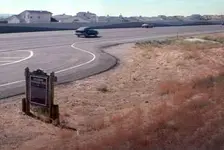Springfield
Silver Member
- Joined
- Apr 19, 2003
- Messages
- 2,850
- Reaction score
- 1,388
- Golden Thread
- 0
- Location
- New Mexico
- Detector(s) used
- BS
Shortstack said:OK, springfield, please allow me to lay it out in it's most elementary fashion.
1-- A group of Spanish folks are following a trail; knowing all of the signs to look for.
2-- They find a trail marker / monument and spot all of the necessary marks and symbols.
3-- They see a sign that says "reverse what you see".
4-- The easiest way to view the whole layout would be to face away from the spot and hold a mirror up
to shoulder lever and look at the mirror's reverse image for those SPECIAL marks such as rangler
found by using PhotoShop to reverse the image.
Now, I am PREsuming that the Spanish did not have PhotoShop to perform that little chore; so, what would be the simplest way they could accomplish that reversed image? The only answer I could come up with was....................(drum roll please).........................a MIRROR. When you asked if I was kidding; I then explained the history of the mirror and that, most likely, they used a polished metal mirror due to the expense and fragility of GLASS mirrors.
Anything else you need help with, Spring??
Yes, Stack, thanks. Answer me these:
1) You guys see hundreds, if not more, 'Spanish treasure signs', 'monumented treasure trails' and 'Jesuit cache signs' all over TX, NM, AZ, CO, UT, OK, CA and points well beyond. Tell me, where is the evidence of the mining that had to have occurred to warrant all these 'signs', mostly found in unmineralized country?
2) Who were these 'Spanish miners' who found all this gold in North America? There weren't even enough experienced people on the Mexican northern frontier to exploit the deposits in today's Sonora, Durango, Chihuahua, etc., let alone in the unexplored territories in today's USA. Incidentally, the Mexican deposits were proved to be, and continue to be today, much, much richer and more prevalent than what was found in present USA. Why did the Mexicans pass up what was in their own back yard to travel into terra obscura?
3) Conceding to you the fact there were indeed a limited number of mining forays from Mexico into North America, why did the Mexicans go to the trouble of hiding their hard-earned spoils, concoct a complicated monumenting scheme in the wilderness to hopefully be able to relocate same, and then abandon the goods? Why not bring the gold back to Mexico after the mining was over? Oh, Indian trouble, you say? Well, the Indians are going to kill you whether you're carrying gold or not, aren't they? If I went to as much trouble as you imply, I'm sure as he[[ not going to be coming home empty handed.
4) Assuming the Mexicans-Spanish-Jesuit folks did cache some goods in North America - yes, I'll agree some of this may indeed have occurred. If so, why do you expect that the caches are still intact? Why weren't they retrieved? After all, if the code was known by the elite, what has prevented them or their descendants from reading the clues and recovering the loot any time in the past 300 or 400 years?
Do the math, Stack. The numbers don't add up. Neither does the logic of the many 'Spanish treasure' scenarios. Your assumptions and interpretations regarding the carvings, monuments, etc. that are being found are arbitrary, unsupported and unverified. They are 'theoretical possibilities', yes, I guess - but most of what you guys hang your hats on ('King's Code', Kenworthy, etc.) are not real except within a group of true believers who have essentially been misled.
Are you finding valid 'signs' in the hills? Yes, indeed, you most assuredly are. Are the signs man made for a purpose? Yes, they are. 99% of them were created by surveyors, prospectors, cowboys, homesteaders, explorers, pioneers, hunters, timber cruisers, trappers, soldiers, hikers, hippies, tree thinners, forest service people, pranksters, and on and on. They mark trails, control points, boundaries, claim corners, campsites and any number of other useful things. 1% may have something to do with hidden valuables.
The gazillion rock pictures that look like ducks, owls, poodles, Lady Gaga, etc. are simply that - rocks that look like something. Save your brain.
Bottom line: the 'Spanish miners' were not that active in North America. Those who found something took it home with them. Nearly all 'treasure signs' are something else. The 'genuine' treasure signs are meant to confuse and cannot be solved by an outsider. The trick is to put unproductive things behind you and focus on that 1%. Who, where, how, why?
And, EE, and Stack, too - I'm dead serious and not just trying to be a smart-a$$. 'Treasure hunting' is 100% about disinformation. I know you are very bright, motivated and have a lot invested in your work. Use your own brain - don't just swallow what's handed to you. It's tough to switch focus and even tougher to abandon what you've so carefully built. I was once like you, someday you may be like me.







